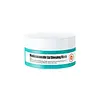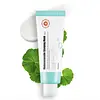What's inside
What's inside
 Key Ingredients
Key Ingredients

 Benefits
Benefits

 Concerns
Concerns

No concerns
 Ingredients Side-by-side
Ingredients Side-by-side

Phytosteryl/Isostearyl/Cetyl/Stearyl/Behenyl Dimer Dilinoleate
Skin ConditioningHydrogenated Polyisobutene
EmollientHydrogenated Poly(C6-14 Olefin)
EmollientPetrolatum
EmollientMicrocrystalline Wax
Emulsion StabilisingMethyl Hydrogenated Rosinate
PerfumingCentella Asiatica Leaf Water
Skin ConditioningCentella Asiatica Leaf
Skin ConditioningMoringa Oleifera Seed Oil
EmollientSucrose Tetrastearate Triacetate
EmollientDiisostearyl Malate
EmollientPolyethylene
AbrasiveEthylene/Propylene/Styrene Copolymer
Butylene/Ethylene/Styrene Copolymer
Tocopherol
AntioxidantGlyceryl Caprylate
EmollientMadecassoside
AntioxidantAsiaticoside
AntioxidantGlycerin
HumectantCeramide NP
Skin ConditioningPhytosphingosine
Skin ConditioningHydrogenated Lecithin
EmulsifyingPhytosteryl/Isostearyl/Cetyl/Stearyl/Behenyl Dimer Dilinoleate, Hydrogenated Polyisobutene, Hydrogenated Poly(C6-14 Olefin), Petrolatum, Microcrystalline Wax, Methyl Hydrogenated Rosinate, Centella Asiatica Leaf Water, Centella Asiatica Leaf, Moringa Oleifera Seed Oil, Sucrose Tetrastearate Triacetate, Diisostearyl Malate, Polyethylene, Ethylene/Propylene/Styrene Copolymer, Butylene/Ethylene/Styrene Copolymer, Tocopherol, Glyceryl Caprylate, Madecassoside, Asiaticoside, Glycerin, Ceramide NP, Phytosphingosine, Hydrogenated Lecithin
Water
Skin ConditioningCentella Asiatica Leaf Water
Skin ConditioningBeeswax
Emulsion StabilisingButylene Glycol
HumectantButyrospermum Parkii Butter
Skin ConditioningCetyl Alcohol
EmollientHexylene Glycol
EmulsifyingNiacinamide
SmoothingHydrogenated Polydecene
EmollientSimmondsia Chinensis Seed Oil
EmollientMoringa Oleifera Seed Oil
EmollientBetaine
HumectantDiglycerin
HumectantGlyceryl Stearate
EmollientPentaerythrityl Tetraethylhexanoate
EmollientPhytosteryl/Isostearyl/Cetyl/Stearyl/Behenyl Dimer Dilinoleate
Skin ConditioningAmmonium Acryloyldimethyltaurate/Vp Copolymer
Caprylyl Methicone
Skin ConditioningHydroxyacetophenone
AntioxidantCetearyl Glucoside
EmulsifyingCaprylic/Capric Triglyceride
MaskingGlycerin
HumectantMadecassoside
AntioxidantAdenosine
Skin ConditioningHydrogenated Lecithin
Emulsifying1,2-Hexanediol
Skin ConditioningCeramide NP
Skin ConditioningGlycosphingolipids
EmollientStearic Acid
CleansingEthylhexylglycerin
Skin ConditioningPhytosphingosine
Skin ConditioningCetearyl Alcohol
EmollientDisodium EDTA
Water, Centella Asiatica Leaf Water, Beeswax, Butylene Glycol, Butyrospermum Parkii Butter, Cetyl Alcohol, Hexylene Glycol, Niacinamide, Hydrogenated Polydecene, Simmondsia Chinensis Seed Oil, Moringa Oleifera Seed Oil, Betaine, Diglycerin, Glyceryl Stearate, Pentaerythrityl Tetraethylhexanoate, Phytosteryl/Isostearyl/Cetyl/Stearyl/Behenyl Dimer Dilinoleate, Ammonium Acryloyldimethyltaurate/Vp Copolymer, Caprylyl Methicone, Hydroxyacetophenone, Cetearyl Glucoside, Caprylic/Capric Triglyceride, Glycerin, Madecassoside, Adenosine, Hydrogenated Lecithin, 1,2-Hexanediol, Ceramide NP, Glycosphingolipids, Stearic Acid, Ethylhexylglycerin, Phytosphingosine, Cetearyl Alcohol, Disodium EDTA
Ingredients Explained
These ingredients are found in both products.
Ingredients higher up in an ingredient list are typically present in a larger amount.
Centella Asiatica Leaf Water is created by distilling centella asiatica leaves. Centella Asiatica is a herb native to Southeast Asia.
Many active components found in Centella Asiatica Extract, such as Madecassic Acid and Asiaticoside, encourage the skin to naturally produce hyaluronic acid. This helps keep our skin hydrated. Many of these components also show antioxidant activity and may help reduce the signs of aging.
Other components of Centella Asiatic Extract include Vitamin A, vitamin C, several B vitamins, and Asiatic Acid.
Learn more about Centella Asiatica Leaf WaterCeramide NP is a type of ceramide and formally known as ceramide 3.
Ceramides are intercellular lipids naturally found in our skin that bonds dead skin cells together to create a barrier. They are known for their ability to hold water and thus are a great ingredient for dry skin.
Ceramides are an important building block for our skin barrier. A stronger barrier helps the skin look more firm and hydrated. By bolstering the skin ceramides act as a barrier against irritating ingredients. This can help with inflammation as well.
If you would like to eat ceramides, sweet potatoes contain a small amount.
Read more about other common types of ceramides here:
Ceramide AP
Ceramide EOP
Glycerin is already naturally found in your skin. It helps moisturize and protect your skin.
A study from 2016 found glycerin to be more effective as a humectant than AHAs and hyaluronic acid.
As a humectant, it helps the skin stay hydrated by pulling moisture to your skin. The low molecular weight of glycerin allows it to pull moisture into the deeper layers of your skin.
Hydrated skin improves your skin barrier; Your skin barrier helps protect against irritants and bacteria.
Glycerin has also been found to have antimicrobial and antiviral properties. Due to these properties, glycerin is often used in wound and burn treatments.
In cosmetics, glycerin is usually derived from plants such as soybean or palm. However, it can also be sourced from animals, such as tallow or animal fat.
This ingredient is organic, colorless, odorless, and non-toxic.
Glycerin is the name for this ingredient in American English. British English uses Glycerol/Glycerine.
Learn more about GlycerinHydrogenated Lecithin is created from the hydrogenation of lecithin (a group of phospholipids). Hydrogenation is a chemical reaction between hydrogen and another element.
This ingredient is an emollient and emulsifier. As an emollient, it helps soften skin by trapping moisture within. As an emulsifier, it prevents oil and water ingredients from separating.
Madecassoside comes from the super popular skin-soothing ingredient, Centella asiatica. It is one of four active compounds found in the extract of Centella Asiatica.
Madecassoside has antioxidant, anti-inflammatory, and hydrating properties. It contains fatty acids, amino acids, beta-carotene, and phytochemicals.
One study found using Madecassoside with ascorbic acid helped reduce the signs of aging and improved skin hydration.
Learn more about MadecassosideMoringa Oleifera Seed Oil is the oil expressed from the seeds of Moringa oleifera plant. It is more commonly known as Moringa seed oil.
Moringa seeds have antioxidant, anti-inflammatory, and skin hydrating properties. These seeds are rich in oils, proteins, monounsaturated fats, and tocopherols.
As an emollient, moringa seed oil helps trap moisture in the skin by creating a film on top. This helps keep your skin hydrated and soft.
Many compounds in moringa seed oil are antioxidant and anti-inflammatory. These compounds include Vitamin E. , catechins, ferulic acid, and more.
Another compound found in Moringa seed oil is oleic acid.
Moringa trees are native to the Himalayan mountains.
This ingredient may not be fungal-acne safe.
Learn more about Moringa Oleifera Seed OilPhytosphingosine is a phospholipid naturally found in our skin as a building block for ceramides.. It helps moisturize, soothe, and protect skin.
Phytosphingosine contributes to your skin's natural moisturizing factor (NMF). The NMF is responsible for hydration, a strong barrier, and plasticity. Our NMF decreases with age. Increasing NMF leads to more healthy and hydrated skin.
Studies show products formulated with NMF ingredients help strengthen our skin's barrier. Having a healthy skin barrier reduces irritation and increases hydration. Our skin barrier is responsible for having plump and firm skin. It also helps protect our skin against infection, allergies, and inflammation.
Fun fact: Phytosphingosine is abundant in plants and fungi.
More ingredients that help boost collagen in skin:
Learn more about PhytosphingosineWe don't have a description for Phytosteryl/Isostearyl/Cetyl/Stearyl/Behenyl Dimer Dilinoleate yet.